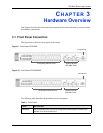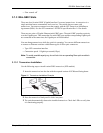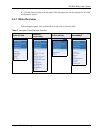
ES-2024 Series User’s Guide
43 Chapter 3 Hardware Overview
3.1.1 Console Port
For local management, you can use a computer with terminal emulation software configured
to the following parameters:
• VT100 terminal emulation
• 9600 bps
• No parity, 8 data bits, 1 stop bit
• No flow control
Connect the male 9-pin end of the console cable to the console port of the switch. Connect the
female end to a serial port (COM1, COM2 or other COM port) of your computer.
3.1.2 Ethernet Ports
The switch has 24 10/100Mbps auto-negotiating, auto-crossover Ethernet ports. In 10/
100Mbps Fast Ethernet, the speed can be 10Mbps or 100Mbps and the duplex mode can be
half duplex or full duplex.
There are two pairs of Gigabit Ethernet/mini-GBIC ports. The mini-GBIC ports have priority
over the Gigabit ports. This means that if a mini-GBIC port and the corresponding Gigabit port
are connected at the same time, the Gigabit port will be disabled. The speed of the Gigabit
Ethernet/mini-GBIC ports can be 100Mbps or 1000Mbps and the duplex mode can be half
duplex (at 100 Mbps) or full duplex.
An auto-negotiating port can detect and adjust to the optimum Ethernet speed (10/100Mpbs)
and duplex mode (full duplex or half duplex) of the connected device.
An auto-crossover (auto-MDI/MDI-X) port automatically works with a straight-through or
crossover Ethernet cable.
3.1.2.1 Default Ethernet Settings
The factory default negotiation settings for the Ethernet ports on the switch are:
• Speed: Auto
• Duplex: Auto
24 10/100 Mbps
RJ-45 Ethernet
Ports
Connect these ports to a computer, a hub, an Ethernet switch or router.
Gigabit
Ethernet/ mini
GBIC ports
Connect these Gigabit Ethernet ports to high-bandwidth backbone network Ethernet
switches or use them to daisy-chain other switches.
Alternatively, use mini-GBIC transceivers in these slots for fiber-optical connections to
backbone Ethernet switches
Table 1 Front Panel (continued)
LABEL DESCRIPTION


















